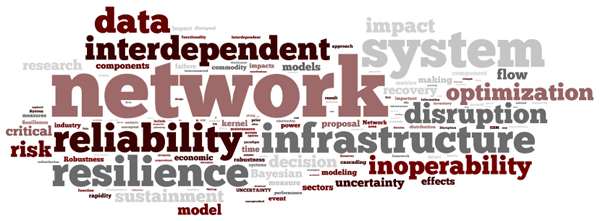
Research
Research Interests
Our general research interests lie in risk analytics applied to the reliability, resilience, and economic impacts of disruptions to cyber-physical-social systems, including physical infrastructure networks, the community networks that rely on them, and the service networks that are engaged after disruptions. Several current projects include the following.
Interdependent network resilience analytics. Recent natural disasters have challenged our traditional approaches of planning for and managing disruptive events. Today, social media provides an opportunity to make use of community-driven data to help us understand the resilience, or lack thereof, of community networks (e.g., friends, neighborhoods) physical infrastructure networks (e.g., transportation, electric power) and networks of service providers (e.g., emergency responders, restoration crews). This collaborative research project integrates multiple disciplinary perspectives in engineering, computer science, and social science to address how community-driven data can help (i) understand the behavior of these interdependent networks before, during, and after disruptions, and (ii) more effectively reduce their vulnerability to and enhance their recovery after a disruption. The first of two research components creates a network model of the interdependence of cyber-physical-social networks and explores the functional relationships between community resilience and infrastructure network performance. The second research component integrates the interdependent network model with community-sourced data to develop a framework of data analytics to better understand and plan for resilience.
Data-driven recovery of infrastructure and community networks. The US government has increasingly emphasized resilience planning for critical infrastructure, where the combination of withstanding and recovering from disruptions that exacerbate our aging and vulnerable infrastructure systems constitutes resilience. Of particular interest recently is an emphasis on the resilience of communities after a disruptive event, acknowledging that infrastructures do not exist for their own sake but serve society (e.g., citizens, industries). The objective of this collaborative project is to develop a new data-driven optimization framework to improve (i) the ability to model the performance of infrastructure networks, and (ii) the ability to plan for the recovery of these networks after a disruption, with an emphasis on community resilience and economic productivity. The first component of three components develops a new statistical technique, the hierarchical Bayesian kernel method, which integrates the Bayesian property of improving predictive accuracy as data are dynamically obtained, the kernel function that adds specificity to the model and can make nonlinear data more manageable, and the hierarchical property of borrowing information from different sources in sparse and diverse data situations which are common in disruptive events scenarios. The second component develops an infrastructure network recovery optimization formulation that minimizes the larger impact of network performance with data-driven (and dynamically updated) hierarchical Bayesian kernel parameters of infrastructure recovery. The third component applies the new integrated methodology to electric power networks (where impact is measured on the safety and resilience of the community) and inland waterways (where impact is measured on economic productivity across multiple industries).
Resilience and impact in multi-modal transportation networks. Recent US planning documents focus on transportation network preparedness, emphasizing “securing and managing flows of people and goods” along transportation networks. This project addresses the vulnerability dimension of resilience by approaching the importance of the components in a multi-modal transportation network relative to their commodity flows and the interdependent, multi-regional, multi-industry impact of those commodity flows. The project (i) relates disruptions to interdependent multi-industry and multi-regional losses, (ii) characterizes transportation network components to multi-regional, multi-industry economic vulnerability, and (iii) develops a means to measure the effectiveness of preparedness decisions to reduce the impacts of transportation network disruptions (e.g., via optimal re-routing, via increased capacity, via network completion) among different transportation modes.
Multi-sourcing resilient supplier selection. Recognizing the inevitability of large-scale disruptions, emphasis in supply chain decision making has shifted from prevention and protection to resilience, or the ability to withstand, adapt to, and recover in a timely manner from a disruptive event. This project addresses resilient supplier selection, a significant concern across industry and government enterprises, developing a supplier selection decision framework that includes (i) a mathematical formulation for multi-sourced supplier selection that considers multiple objectives of maximizing capacity, minimizing tardiness, maximizing reliability, and minimizing costs, among potentially others, and (ii) a means to address uncertainty underlying the occurrence of a disruptive event.

